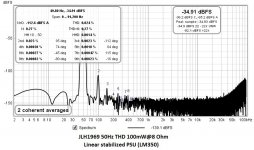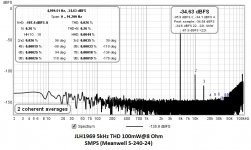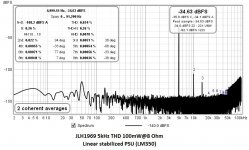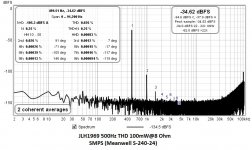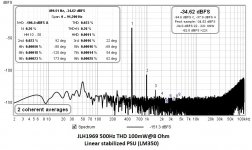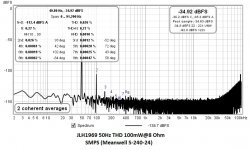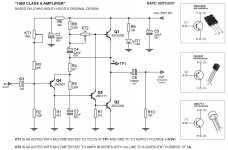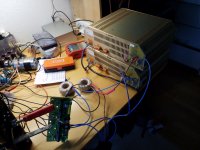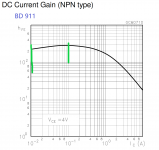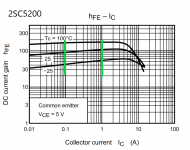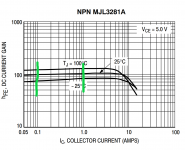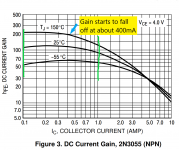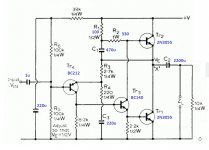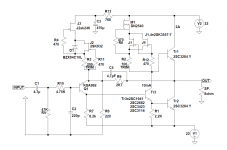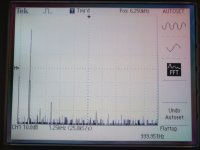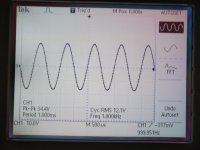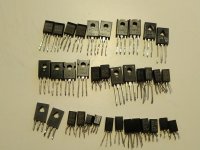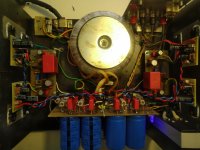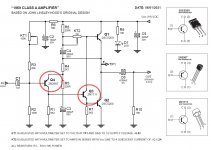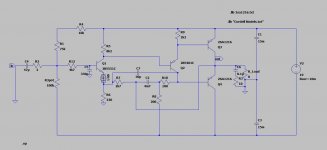Very happy with the sound. I thought the switching PSU was going to be noisy, but heard only very faint switching noises with my ears against the speaker.
I haven’t measured the PS rejection ratio of this amplifier.
Check the attached screenshots of my JLH1969 amp output.
Three pairs. First in each pair, a stabilized (LM350T) linear PSU, second an SMPS (Meanwell S-240-24) are feeding the amplifier. Noise floor is a bit lower with the SMPS
You may achieve reduction of the excessive noise from the fan. Try to wash/clean the blades and then lubricate the motor.The loudest is the fan, that was pulled from a retired server, so its bearings probably had a hard life. I've got a super quiet magnetic levitation vapor bearing fan on order.
George
Attachments
Check the attached screenshots of my JLH1969 amp output.
Three pairs. First in each pair, a stabilized (LM350T) linear PSU, second an SMPS (Meanwell S-240-24) are feeding the amplifier. Noise floor is a bit lower with the SMPS
George, thanks for sharing the data. Very interesting that the noise floor of the SMPS is actually lower than the linear one. Also looking at harmonic spikes, they are also narrower for the SMPS one, suggesting a cleaner output.
This is the first time I'm using a SMPS for an audio amplifier and can't pick any faults with it. The constant current draw of a class A amp is probably also SMPS friendly. You data sure backs that up.
I suppose bulk of the switching noise from the SMPS is beyond the hearing spectrum, plus I think Meanwell makes decent SMPS as well. Used a few of them before but not for this project. I've used a cheap eBay one, but swapped out the caps for quality ones from another new but scrapped SMPS. I'm sure the very faint background noise will go away with a Meanwell one. I initially hooked the amp up to my bench power supply which is also a SMPS and it was dead quiet.
You may achieve reduction of the excessive noise from the fan. Try to wash/clean the blades and then lubricate the motor.
Thanks for the suggestion. Blades are clean and I've lowered the speed of the fan. Running on 6v vs 12v and still keeping things cool. So the noise is not from the rush of air but the higher pitched metal to metal contact, not squeaking but soft and noticeable nonetheless.
Never thought about lubricating the motor. Reading up about sleeve bearings, it appears that the oil evaporates after a few years. Your suggestion could very well solve the problem. I'll give it a shot.
I've ordered a 17.7db Maglev fan, its cheap if you pick the right source. I got a Sunon one from Mouser. They are probably the manufacturer that supplies to the PC accessories mob who then mark up the price considerably.
https://au.mouser.com/ProductDetail/369-HA92251V41UA99/
This is how my JLH1969 built about 45-47 years ago measures today (I am in the process of verifying the performance of my amplifiers)
BC212 (Siemens), BC 140 (Siemens), 2N3055 (Motorola).
1uF MKT input, 470uF bootstrap, 2200uF output (capacitors are some 15 years old).
1 Ampere per channel at 24Vdc
George
Hi gpapag,
Do you have the diagram of circuit?
could make available?
Thanks!
I am use 2N2907 and 2N1711, 2x 2SC5200 and output 4700uF. 19V DC.
IQ = 1.2A
Attachments
The circuit is the same (except for the LED). LEDs were inaccessible in 1969.
MJ480 and 2N3055 (Motorola) is not available now 🙂
MJ480 and 2N3055 (Motorola) is not available now 🙂
Arctic cooling make 120mm fans with a temp. Probe attacched on a cable, it increases speed according to temperature, very nice silent fans.
The smps works very well, for my jlh and hiraga builds I tested them on two series connected smps, 40 amp each, noise was extremely low, and the smps dont mind common mode choke and 33000uf strapped on.
Only bummer is their size.
The smps works very well, for my jlh and hiraga builds I tested them on two series connected smps, 40 amp each, noise was extremely low, and the smps dont mind common mode choke and 33000uf strapped on.
Only bummer is their size.
Attachments
Old DIY - ON Semi still have 2N3055G as active.
Of course Motorola split off into ON Semi so a Motorola device is not available.
But I'd suggest the 2SC5200 or an MJL3281A output would be better.
Of course Motorola split off into ON Semi so a Motorola device is not available.
But I'd suggest the 2SC5200 or an MJL3281A output would be better.
But I'd suggest the 2SC5200 or an MJL3281A output would be better.
John, totally agree with you. I was looking at the current/gain curve when deciding whether my BD911's would be acceptable for the JLH amp (I did not have any 2SC5200 or MJL3281's on hand).
It's interesting that the 2N3005 actually has some decent gain at low currents, but that starts to fall off very dramatically over about 400mA.
Fine for class AB amps where most of the listening, especially in the sensitive 1-5khz range, draws just a few watts. This probably corroborates with the 2N3055's being behind some famous class AB amps like the NAD 3020.
But using the 2N3055 on a class A amp would be a different story. Even the 1-1.2A current draw of the 1969 JLH will take it out of its linear gain range. I've attached some gain/current charts and highlighted the probable operating area for the 1969 JLH between two green lines.
Linearity is almost flat for 2SC5200 and MJL3281. Acceptable for the BD911 but falls off quite steeply for the 2N3055.
Attachments
Hi gpapag,
Do you have the diagram of circuit?
could make available?
Thanks!
I am use 2N2907 and 2N1711, 2x 2SC5200 and output 4700uF. 19V DC.
IQ = 1.2A
Hi Tiago.
Here is the schematic (only because you asked for it). Nothing special, no reason to go by it.
Your implementation looks more promising. 🙂
George
Attachments
2N2907 probably isn't an ideal choice for an audio input transistor. Normally, you find it in elementary electronics teaching kits because for decades, along with 2N2222, it was in vast oversupply, cheap, good for low speed switching, low level DC amplifying and available everywhere.
Some folk seem to prefer the aesthetics of shiny metal cased semis but that's no reason to compromise on noise level, for example so I would use originally specified 2N3904, or perhaps other lower-noise audio types. You need linearity from a driver transistor so use the specified part or perhaps substitute BD139/2SD669A etc.
I think you should try to get closer to the original spec. of TR3,4 transistors or the net result won't be very good.
Some folk seem to prefer the aesthetics of shiny metal cased semis but that's no reason to compromise on noise level, for example so I would use originally specified 2N3904, or perhaps other lower-noise audio types. You need linearity from a driver transistor so use the specified part or perhaps substitute BD139/2SD669A etc.
I think you should try to get closer to the original spec. of TR3,4 transistors or the net result won't be very good.
Last edited:
2N2907 probably isn't an ideal choice for an audio input transistor. Normally, you find it in elementary electronics teaching kits because for decades, along with 2N2222, it was in vast oversupply, cheap, good for low speed switching, low level DC amplifying and available everywhere.
Some folk seem to prefer the aesthetics of shiny metal cased semis but that's no reason to compromise on noise level, for example so I would use originally specified 2N3904, or perhaps other lower-noise audio types. You need linearity from a driver transistor so use the specified part or perhaps substitute BD139/2SD669A etc.
I think you should try to get closer to the original spec. of TR3,4 transistors or the net result won't be very good.
Hi Ian Finch, how are you? In this attached circuit of mine, do you think I better change the transistors Q4 and Q3? Q4 PNP (2N2907), which one to replace? and Q3 NPN (2N1711), replace with BD139?
Thanks for listening.🙂
Attachments
In this attached circuit of mine, do you think I better change the transistors Q4 and Q3? Q4 PNP (2N2907), which one to replace? and Q3 NPN (2N1711), replace with BD139?
Thanks for listening.🙂
You could consider replacing 2N1711 with a ZTX450. It has better gain and linearity than both the BD139 and 2N1711. I used it in my recent build and it sounds good.
Some concerns that it comes in a tiny E-Line package, but its specs add up and they were not at all warm when I measured them.
I replaced the Q4 (2N2907) with a BC560, a low noise signal transistor. But original ones are difficult to get these days with lots of fakes around. Apparently BC850 shares the same die as the BC560 but its in a SMD package.
You could consider replacing 2N1711 with a ZTX450. It has better gain and linearity than both the BD139 and 2N1711. I used it in my recent build and it sounds good.
Some concerns that it comes in a tiny E-Line package, but its specs add up and they were not at all warm when I measured them.
I replaced the Q4 (2N2907) with a BC560, a low noise signal transistor. But original ones are difficult to get these days with lots of fakes around. Apparently BC850 shares the same die as the BC560 but its in a SMD package.
Thanks! Altus Fidelitas!!
I will change the transistors. I will put the ZTX450 and BC560.
One more question on transistor matching in the JLH 1969.
Hood is clear about the use of matched and unmatched pairs in each channel, however what about as compared between channels?
For example, lets say I test all my transistors and I find 2 perfect matches. 2 transistors are found to have a gain of 39 and two are found to have a gain of 46.
According to JLH's testing, the ideal configuration for one channel is to have matched pairs - so it makes sense to put the 2 transistors with 39 gain in one channel and the two with 46 gain in the other channel.
However, (and I am showing my lack of knowledge here 🙂 ) will this mean that one channel will have distinctly higher gain than the other channel?
If so, it perhaps makes more sense to fall back to JLH's second recommendation - if you can't find a match, then put the higher gain transistor in Tr1 position.
Therefore the 46 gain transistors in Tr1 of each channel and the 39 gain transistors in Tr2 of each channel.
What say you all?
Hood is clear about the use of matched and unmatched pairs in each channel, however what about as compared between channels?
For example, lets say I test all my transistors and I find 2 perfect matches. 2 transistors are found to have a gain of 39 and two are found to have a gain of 46.
According to JLH's testing, the ideal configuration for one channel is to have matched pairs - so it makes sense to put the 2 transistors with 39 gain in one channel and the two with 46 gain in the other channel.
However, (and I am showing my lack of knowledge here 🙂 ) will this mean that one channel will have distinctly higher gain than the other channel?
If so, it perhaps makes more sense to fall back to JLH's second recommendation - if you can't find a match, then put the higher gain transistor in Tr1 position.
Therefore the 46 gain transistors in Tr1 of each channel and the 39 gain transistors in Tr2 of each channel.
What say you all?
Last edited:
When I was doing my first JLH69 a couple of years ago I tested a lot of transistors on it, especially for the driver and input transistor. I tested maybe about 40 types of transistors for the driver and about 10 transistors for the input stage. Tests were done listening and accompanied by an oscilloscope.
For input, the best were KSA992 (2SA992) and SMD 2SA1312 (2SA970), I also tested BC560 but it is not a shadow of 2SA ...
For the driver, the transistor must have as low a Cob as possible and a higher fT with high gain, old video transistors like 2SC2705 and similar proved to be excellent, I had the best results with 2SC2682 and 2SC1941.
For the output I use a transistor with fT of 80MHz and it works without problems, compensation was needed only in combination 2SC1941 + 2SC3284.
No need to look for transistors that will match those originally used in JLH but should be further explored.
There are a lot of better transistors today and I’m sure they will provide a lot more enjoyment with JLH than with the original transistors.
Why not improve something, it’s a real DIY spirit.
For input, the best were KSA992 (2SA992) and SMD 2SA1312 (2SA970), I also tested BC560 but it is not a shadow of 2SA ...
For the driver, the transistor must have as low a Cob as possible and a higher fT with high gain, old video transistors like 2SC2705 and similar proved to be excellent, I had the best results with 2SC2682 and 2SC1941.
For the output I use a transistor with fT of 80MHz and it works without problems, compensation was needed only in combination 2SC1941 + 2SC3284.
No need to look for transistors that will match those originally used in JLH but should be further explored.
There are a lot of better transistors today and I’m sure they will provide a lot more enjoyment with JLH than with the original transistors.
Why not improve something, it’s a real DIY spirit.
Attachments
@cogitech
I've only explored about half a dozen types of transistor, mainly in the output stages. While the distortion may be lower with a matched pair, if it were me, I would be inclined to use the 46+39 combination in both channels for best stereo matching. That's not a large mismatch anyway.
Unfortunately the gains are lower than ideal.
I'm not sure what JLH meant when he said gains were high or low since those old devices he would have used had a high gain at medium currents (~300mA) but reduced at ~2A or so.
Modern devices with gains of 100 at 2A or more should do better. I've certainly had good results from 2SC5200 and MJL3281A, but you may need compensation as Grunf shows. Though I'd still use a bootstrap to get most power out. Or a current source with a PNP perhaps even fed from a hgiher supply rail.
@Ian - what do you think is the problem with modern transistors?
I've only explored about half a dozen types of transistor, mainly in the output stages. While the distortion may be lower with a matched pair, if it were me, I would be inclined to use the 46+39 combination in both channels for best stereo matching. That's not a large mismatch anyway.
Unfortunately the gains are lower than ideal.
I'm not sure what JLH meant when he said gains were high or low since those old devices he would have used had a high gain at medium currents (~300mA) but reduced at ~2A or so.
Modern devices with gains of 100 at 2A or more should do better. I've certainly had good results from 2SC5200 and MJL3281A, but you may need compensation as Grunf shows. Though I'd still use a bootstrap to get most power out. Or a current source with a PNP perhaps even fed from a hgiher supply rail.
@Ian - what do you think is the problem with modern transistors?
Based on the recent discussion, I have just placed an order for some 2SC5200. They are easier for me to get, affordable and seem like a better bet than BD911.
Actually, with this change it appears that I will be building the exact same schematic as posted by sierratds.
Actually, with this change it appears that I will be building the exact same schematic as posted by sierratds.
Last edited:
When I was doing my first JLH69 a couple of years ago I tested a lot of transistors on it, especially for the driver and input transistor. I tested maybe about 40 types of transistors for the driver and about 10 transistors for the input stage. Tests were done listening and accompanied by an oscilloscope.
For input, the best were KSA992 (2SA992) and SMD 2SA1312 (2SA970), I also tested BC560 but it is not a shadow of 2SA ...
For the driver, the transistor must have as low a Cob as possible and a higher fT with high gain, old video transistors like 2SC2705 and similar proved to be excellent, I had the best results with 2SC2682 and 2SC1941.
For the output I use a transistor with fT of 80MHz and it works without problems, compensation was needed only in combination 2SC1941 + 2SC3284.
No need to look for transistors that will match those originally used in JLH but should be further explored.
There are a lot of better transistors today and I’m sure they will provide a lot more enjoyment with JLH than with the original transistors.
Why not improve something, it’s a real DIY spirit.
Hi grunf, thanks for sharing your tests.
I will do a test with the Transistors:
Q4 = 2SA992, Q3 = 2SC2682.
Thanks.
Attachments
- Home
- Amplifiers
- Solid State
- JLH 10 Watt class A amplifier
